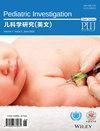Safety of removal of ProSeal laryngeal mask airway in children in the supine versus lateral position in a deep plane of anesthesia: A randomized controlled trial
IF 2
4区 医学
Q2 PEDIATRICS
引用次数: 0
Abstract
ABSTRACT Importance When a ProSeal laryngeal mask airway (PLMA) is removed with the child in a deep plane of anesthesia, the upper airway muscle tone and protective upper airway reflexes may be obtunded. Objective To determine whether the supine or lateral position is safer for the removal of a PLMA in deeply anesthetized children by comparing the incidence of upper airway complications. Methods This randomized single‐blind comparative trial was conducted at a tertiary care hospital between January 2020 and September 2020. Forty children of the American Society of Anesthesiologists class I/II of ages 1–12 years age undergoing surgery under general anesthesia with PLMA used as the definitive airway device were recruited. Patients were randomly allocated to lateral group or supine group for PLMA removal in a deep plane of anesthesia in the lateral or supine position. The primary outcome was the number of patients experiencing one or more upper airway complications and the secondary outcomes were incidence of individual respiratory adverse effects and of severe airway complications. Results The incidence of airway complications was 30% in the supine group and 20% in the lateral group ( P = 0.6641). Incidence of laryngospasm, immediate stridor, and excessive secretions were similar. Early stridor and oxygen desaturation were higher in the supine group ( P = 0.0374, P = 0.0183 respectively). Interpretation The overall incidence of upper airway complications was similar with the removal of a PLMA in the supine or lateral position in deeply anesthetized children. The incidence of oxygen desaturation and stridor were higher with PLMA removal in the supine as compared to the lateral position.深平面麻醉下儿童仰卧位与侧卧位去除ProSeal喉罩气道的安全性:一项随机对照试验
当儿童在深度麻醉平面下移除ProSeal喉罩气道(PLMA)时,上气道肌张力和保护性上气道反射可能会被阻断。目的通过比较深度麻醉患儿上呼吸道并发症的发生率,探讨仰卧位和侧卧位是否更安全。方法:该随机单盲比较试验于2020年1月至2020年9月在一家三级保健医院进行。招募了40名年龄在1-12岁的美国麻醉师学会I/II级儿童,他们在全身麻醉下接受手术,使用PLMA作为最终气道装置。将患者随机分为侧卧位组和仰卧位组,分别在侧卧位和仰卧位深度麻醉平面下取出PLMA。主要结局是出现一种或多种上呼吸道并发症的患者数量,次要结局是个体呼吸不良反应和严重气道并发症的发生率。结果仰卧位组气道并发症发生率为30%,侧卧位组为20% (P = 0.6641)。喉痉挛、立即喘鸣和分泌物过多的发生率相似。仰卧位组早期喘鸣和氧饱和度较高(P = 0.0374, P = 0.0183)。结论:深度麻醉患儿在仰卧位或侧卧位取下PLMA时,上呼吸道并发症的总体发生率相似。与侧卧位相比,在仰卧位移除PLMA时,氧不饱和和喘鸣的发生率更高。
本文章由计算机程序翻译,如有差异,请以英文原文为准。
求助全文
约1分钟内获得全文
求助全文
来源期刊

Pediatric Investigation
Medicine-Pediatrics, Perinatology and Child Health
CiteScore
3.30
自引率
0.00%
发文量
176
审稿时长
12 weeks
 求助内容:
求助内容: 应助结果提醒方式:
应助结果提醒方式:


